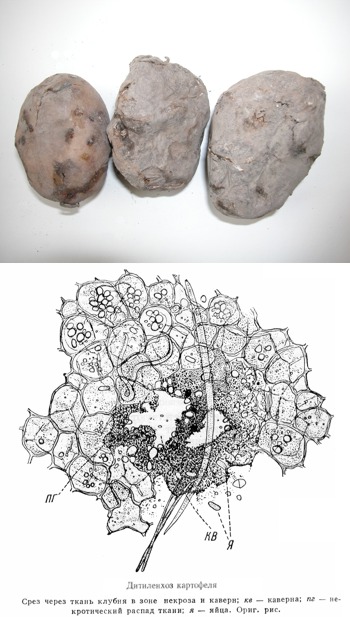Pests
Ditylenchus destructor Thorne - Potato Rot Nematode
Systematic position.
Type Nemathelminthes, class Nematoda, subclass Secernentea, order Tylenchida, family Tylenchidae, genus Ditylenchus.Biological group.
Obligate parasite.Morphology and biology.
Microscopic coelelminth worms (appr. 1.4 x 0.032 mm). Females, males, larvae of I-IV age are vermiform; eggs reniform. Biological cycle takes place in tubers, where the nematodes eat starch grains. As a result, the affected tissue becomes powdery and brown. Tuber surface is covered with dark spots having dry cracked peel. The nematodes live inside boundary of living tissue, where they can abundantly aggregate because of the high fertility of females (up to 250 eggs) and short cycle of development (15-45 days). During the winter period the nematodes live in tubers, affecting new potato tubers through stolons of planting stock. The soil plays a secondary role in nematode transfer.Distribution.
The area was established during the period of high damage caused by the Potato Rot Nematode in the 1960-70s. The pest was distributed throughout all zones of potato growing in the former USSR, both in northern and southern latitudes.Ecology.
This ecologically plastic species is distributed throughout all climatic zones of potato cultivation. It is a polyphage, able to survive on other host plants (garlic, onion, beet, carrot, tomato, cucumber, pumpkin, eggplant, pepper, watermelon).Economic significance.
The Potato Rot Nematode damages tubers during storage, especially under abnormal conditions of storage (i.e. high temperature). As a result, seed material becomes infected. The meristematic method of planting stock production excludes the Potato Rot Nematode, which has reduced the problem.Reference citations:
Burshtein X.S. 1969. Ditylenhus destructor Thorne, 1945 and its control in Lithuanian SSR. PhD Thesis. Leningrad: VIZR. 14 p. (In Russian)Butenko K.O. 2004. Potato nematodes of the central region of Russia (fauna, epiphytotiology, control measures). PhD Thesis. Moscow: TSKhA. 21 p. (In Russian)
Eglitis V.K., Kaktynya D.K. 1972. Heteroderosis and ditilenhosis of potato in Latvian SSR. Pitseskis S., ed. Short reports on plant protection (8th Baltic conference on plant protection). Part 2. Kaunas: MSKh LitSSR. 97-100 p. (In Russian)
Gus'kova L.A, Adimov I.I., Fillipenko Yu.T. 1966. The Potato Rot Nematode control in Byelorussia. Minsk: Urozhai. 16 p. (In Russian)
Kir'yanova E.S., Krall E.L. 1971. Parasitic plant nematodes and their control. V. 2. Leningrad: Nauka. 522 p. (In Russian)
Paramonov A.A., Bryushkova F.I. 1956. The Potato Rot Nematode and its control. Moscow: Academy of sciences of the USSR. 111 p. (In Russian)
Ryss R.G. 1962. The Potato Rot Nematode and its control. Kiev: UASKHM. 119 p. (In Russian)
Saf'yanov S.P. 1964. The Potato Rot Nematode in Kazakhstan. Zashchita rastenii ot vreditelei i boleznei, 9(10): 54. (In Russian)
Shepshelev S.G. 1971. Nematode diseases. In: Polyakov I.Ya., Minkevich I.I., eds. Pests and diseases distribution on agricultural crops in RSFSR in 1970 and the forecast of their appearance in 1971. Moscow: MSKH RSFSR, VIZR. 52-53 p. (In Russian)
Sveshnikova N.M., Teren'eva T.G., Shepshelev 3.G. 1969. Nematodes on agricultural crops. In: Polyakov I.Ya., Chumakov A.E., eds. Pests and diseases distribution on agricultural crops in RSFSR in 1968 and the forecast of their appearance in 1969. Moscow: Rosselkhozizdat. 43-47 p. (In Russian)


